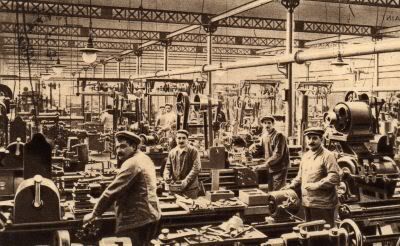The end of the damascus trade.
The technology to build damascus was mothered by the necessity to produce light barrels capable of handling the longitudinal and axial stress of gun powder ignition. This was in an age when it was common to produce a barrel by bending a flat piece of iron around a mandrel and welding it along it's entire length. The combination of iron and steel in tandem with the spiral wrapping produced a significantly stronger and safer firearm.
The reasons the trade ended are multi-faceted. While the destruction of the rolling mills, barrel production centers and decimated work force inflicted by WWI are primary, the trade would have ended eventually.
The change was rooted deep within the fabric of western Europe.
The industrial revolution progressed. Metallurgical developments produced stronger steels. Railroads were built. As the technology to produce stronger steels rose, so too did unionism and the shattering of the guild system.
For many decades, the owners had ruled like barons over their workers. They saw no reason to support state sponsored programs such as schools, health care and the like. They found the federal government intrusive and preferred to cling to their own regional ethnicity's. For a time this view was shared by the labor force. Eventually, as the owners increasing used machines, the workers where displaced. The guild could provide the training needed to learn a trade. The small cottage worker found themselves living in more urban setting with decreasing ability to control their own work habits.
As early as 1849 the S.S.M.O.A.L. or Société de Secours mutuels des Ouvriers Armuriers Liège ( Mutual Aid Society of Liege Arms Workers ) was formed. This early mutual aid society was largely geared to helping workers with things like housing, food, etc.
In 1886 the town of Liege called a meeting of the owners. They had a proposal for them. An establishment of a school to train workers. They suggested that the town would help fund such a school. They would seek funding from the federal government. In addition, they wanted the owners support. The owners drafted a response. They saw no need to educate their labor force. After all, the guild system provided all the education that was required.
One of the 1st truly modern firearms makers in Belgium was Fabrique National. FN was originally founded by a group of owners / investors, Henri Pieper being one, in 1889. It was based on the most modern technology. Large tracts of land were acquired. Huge factories rose, building after building. Labor was needed. There was a rush to the doors as people sought work. FN was looking at a new economy of firearms production. Before a gunmaker-owner simply set a rate for which he purchased parts. He could even pay cottage workers to do the final assembly. Guns per hour, became a new phrase on the owners lips. The work force suffered and finally walked out on strike in 1895. Strikes were not unheard of in Belgium, but were a rare thing for the arms industry. At this time the U.F.A Union des Fabricants d'Armes U.F.A ( Union of Arms Workers ) approached the officials of Liege. They lent their support and the L'école d'Armurerie de Liège ( School of Liege Gun makers ) was founded in 1897.
A sense of national pride was growing in Belgium. With the advent of the railroad, relatively rare and exotic commodities were becoming common place. Oranges, lemons, spices, clothing were now available. People had the bicycle as a means of transport. Things were looking up. The only problem was money. To purchase all this took cash. The owners were staunch. They had paid your father 2 francs per barrel, what made you think your barrels were worth 3 francs? Things came to a head in 1908. The barrel makers guild found themselves locked out. The people of Nessonvaux and Liege opened their hearts and their doors. They took in the children of the barrel makers guild and provided them with food and shelter.
One of the voices of change was Léon Troclet. He supported the workers cause. He called for even more schooling. Léon Troclet was one of the founders of the Belgium Labor Party and of the F.G.T.B. , La Fédération générale du travail de Belgique ( The General Federation of Belgian Labour ), one the largest unions in Belgium.
The strikes continued unfortunately. In 1912, Lochet factory was embroiled in a strike.
Making hammers at home.

The 1905 celebration of the 75th Anniversary of the Republic of Belgium. The guilds walk in the parade.

Factory workers.

Pete